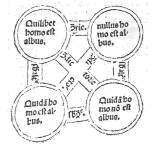Reply to Schiffer
This is a brief response to Stephen Schiffer’s “Reply to MacFarlane” in the PPR book symposium on Schiffer’s The Things We Mean (PPR 73, 2006).
In my contribution to the symposium, I showed that Schiffer’s tentatively proffered rules for computing VPBs and SPBs for truth-functional compounds are jointly inconsistent. In his reply, Schiffer acknowledges the counterexample and proposes to amend his position as follows. Instead of taking VPBs to obey the Łukasiewicz rules when applied to fully indeterminate propositions, he now suggests that
when, for any propositions p, q, VPB(p) + VPB(~p) = VPB(q) + VPB(~q) = 1, then VPB(p&q) and VPB(pvq) = the mean of VPB(p) and VPB(q). (237)
This is a pretty odd suggestion, and not just because it treats disjunction and conjunction the same. Schiffer’s “mean rule” implies that when vague propositions are at stake, one can legitimately endorse a conjuntion more strongly than one of its conjuncts, and endorse a disjunction less strongly than one of its disjuncts. For example, suppose VPB(p) = 0.8 and VPB(q) = 0.2. Then the mean rule says that VPB(p&q) = 0.5. VPB is supposed to measure a species of strength of endorsement. Can it be rational to endorse p&q significantly more strongly than q? (We may assume that p and q have nothing to do with each other.)
But perhaps this oddity can be accepted if it is the price for a consistent theory of VPBs and SPBs. Schiffer notes that the revised theory can handle the case that proved fatal for his original theory:
If we replace (6) and (8) on MacFarlane’s list with, respectively,
VPB(p&q) = Mean[VPB(p), VPB(q)]
VPB(~p v ~q) = Mean[VPB(~p), VPB(~q)]
and then apply the revised list to his example, we get VPB(B&T) = 0.325, VPB(~(B&T)) = 0.175, SPB(B&T) = 0.06, and SPB(~(B&T)) = 0.44, which do sum to 1, as required by
VPB(p) + VPB(~p) + SPB(p) + SPB(~p) = 1,
the “basic law” (219) governing the interaction of VPBs and SPBs. (238)
I agree that the revised system gives good results for this particular example.1 However, it is easy to find counterexamples to the new system of rules. In fact, one of the two counterexamples I gave to Schiffer’s original system is also a counterexample to the new system:
SPB(p) = VPB(p) = SPB(q) = VPB(q) = 0.3, SPB(~p) = VPB(~p) = SPB(~q) = VPB(~q) = 0.2
With these assignments we get
SPB(p&q) = 0.09, SPB(~(p&q)) = SPB(~p v ~q) = 0.4 - 0.04 = 0.36,
VPB(p&q) = 0.3, VPB(~(p&q)) = VPB(~p v ~q) = 0.2.
SPB(p&q) + SPB(~(p&q)) + VPB(p&q) + VPB(~(p&q)) = 0.09 + 0.36 + 0.3 + 0.2 = 0.95 (not 1, as required by Schiffer’s “basic law”).
My second (“bald and tall”) counterexample (the one Schiffer explicitly discusses in his reply) can also be modified slightly to provide a counterexample to Schiffer’s new system. Leave everything about the scenario the same, except for John’s credences about how many hairs Frank has on his head. Change those as follows:
| Credence | Hairs |
|---|---|
| 0.3 | 37 hairs |
| 0.3 | 18 hairs |
| 0.1 | 0 hairs |
| 0.3 | 5000 hairs |
Aplying Schiffer’s method for assigning degrees to atomic propositions and their negations, and using the mean rule to compute VPBs for conjunctions and disjunctions, we get:
SPB(T) = 0.3, SPB(~T) = 0.3, SPB(B) = 0.1, SPB(~B) = 0.3.
VPB(T) = 0.26, VPB(~T) = 0.14, VPB(B) = 0.45, VPB(~B) = 0.15.
SPB(T&B) = 0.03, SPB(~(T&B)) = 0.51, VPB(T&B) = 0.36, VPB(~(T&B)) = 0.15 (summing to 1.04, not 1 as required by Schiffer’s “basic law”)
The fundamental problem with Schiffer’s project is that the “basic law” requires VPB and SPB calculations to go in lockstep with each other, but the rules for calculating VPBs and SPBs are so disparate (whether VPBs are calculated using Łukasiewicz rules or the mean rule) that there is no reason to expect that this will happen. (If Schiffer thinks that it will happen, he should give us a reason to think so, preferably in the form of a proof. Examining a couple of examples is not sufficient, as past efforts demonstrate.)
John MacFarlane, Oct. 1, 2008
Note that Schiffer is here using the “mean rule” to compute VPBs for compounds of p and q even when VPB(p) + VPB(~p) < 1 and VBP(q) + VPB(~q) < 1. This goes beyond what his initial suggestion licenses, since it was restricted to fully indeterminate propositions.↩︎
